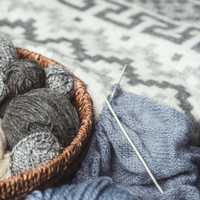Tips for Knitting Newbies
By Christina Sinclair
Tips for Knitting Newbies
By Christina Sinclair
Not considered fashionable for decades, knitting has experienced a recent renaissance.
Knitting is an ancient skill from about a thousand years ago but is clearly still relevant and appealing today as it is rapidly becoming a popular social activity.
It appeals to every demographic it seems: from children to the retired, from models to grannies. Knitting can be useful, money-saving, soothing, creative and even addictive! These are appealing reasons to take up knitting in a modern and often stressful world.
Kitting Yourself Out
Kitting yourself out for your new hobby is not expensive at all.
Buying knitting needle cases full of just about every size of needle available is an unnecessary expense. Even the most experienced knitter will probably never use needles in every size that is produced. Just buy needles as you need them. They should last a lifetime.
The size of needle you need for any yarn is stated on its ball band. But if you don't knit with standard tension you will need another size. Your tension will possibly be quite tight when you start learning, but will loosen when you and your hands become more relaxed.
To knit a garment you will usually need two pairs of needles. The smaller size will be used for the ribbing. To check a size of needle is right for the tension you knit at, the pattern will recommend you knit a tension square. But this exercise is nothing to concern yourself with as a beginner.
You just need to learn how to knit; and a simple square is a good first project.
Knitting needles are made from different materials: plastic, metal, wood and bamboo. Plastic ones might feel the most comfortable to begin with and they do come in an array of colours. Types of needles are a matter of personal choice. Experimenting with different ones can come later.
You will also need a small pair of scissors and perhaps a bag to store all your knitting and equipment in.
If you leave knitting on needles for a long period of time, a mark will appear across your work. So if you have to leave a piece of unfinished knitting aside for a good while, leave it on a stitch holder or a smaller size of knitting needle ready to take up again when you are ready. But as a beginner just learning to knit, you probably won't be making any garment to wear so you need not worry about this problem at this stage.
Don't learn to knit with large needles and chunky yarn. You will need something comfortable to hold in your hands and these might prove too cumbersome to deal with.
Getting Started
It is probably best to start learning with a double knitting yarn on 4mm needles.
Double knitting yarn is manageable, not too thin and not too thick, and comes in a huge selection of colours. Don't work with very dark-coloured yarn like black or navy when you begin learning. If you drop a stitch, it will be very difficult to see.
Once you have learnt to knit you can move on to other thicknesses of yarn and become as creative and experimental as you like - but you need to make things as easy for yourself as possible to start with.
Getting Sociable
There are books and magazines with diagrams to show you how to knit, but knitting is probably a skill best learnt by watching somebody doing it.
Many knitting yarn shops now are starting their own classes and if they don't have anything so formal, they may have a knitting circle that you can join with experienced knitters at hand to help you every time you get stuck or drop a stitch.
Look out for a poster displayed in a prominent position. They will be only too glad to enrol you and if they are full to bursting, they may have a waiting list you can join.
Knitting clubs and cafes are also listed online; there may be one local to you.
Getting More Help
Otherwise, if you have nobody to help you, you can just Google 'how to knit video'. These videos will help you with the different stitches and casting on. Knowing how to knit is not at all difficult. It is just the competence and then picking up speed that takes a little practice.
Different Ideas
Don't worry about using knitting patterns to start with. Making a scarf is a good project when you are learning to knit. You can make it a stripy one to make knitting it more interesting even if you are not a Doctor Who fan!
A scarf should not be knitted in stocking stitch; so learn how to cast on and off and how to do the knit stitch and you will be away!
There is more than one way to cast on. You will choose the one that is easiest for you.
Using the knit stitch in every row is called 'garter stitch' but using the knit stitch and purl stitch alternately in rows is called 'stocking stitch'.
You will probably want to make quite a few items just using garter stitch before you learn how to purl.
Buying Yarn
Always check ball bands when you buy your yarn, all the dye batch numbers should be the same. The assistant may also do this for you as she packs your bag. Keep a ball band for washing instructions.
If the batch numbers are not the same, a line is likely to appear across your work where the colour changes, spoiling the knitting. Make sure you buy enough yarn; there are plenty of ways to use up leftovers!
Even as a beginner, anything you make will probably be unique and so you will never walk down the street and meet someone wearing a replica of your creation.
Beyond the Scarf
When you have knitted your umpteenth scarf there are easy patterns for beginners to be found on the Internet.
Christina Sinclair is a lecturer and self-published children's author with qualifications in design. She is now writing 'The Salty Sam Fun Blog for Children' which is to be found on her website. The blog has articles about history, science, nature, gardening and environmental issues. It also has free craft downloads, knitting patterns, easy recipes and other projects for children: http://www.christina-sinclair.com/blog/
Article Source: http://EzineArticles.com/8982281
Not considered fashionable for decades, knitting has experienced a recent renaissance.
Knitting is an ancient skill from about a thousand years ago but is clearly still relevant and appealing today as it is rapidly becoming a popular social activity.
It appeals to every demographic it seems: from children to the retired, from models to grannies. Knitting can be useful, money-saving, soothing, creative and even addictive! These are appealing reasons to take up knitting in a modern and often stressful world.
Kitting Yourself Out
Kitting yourself out for your new hobby is not expensive at all.
Buying knitting needle cases full of just about every size of needle available is an unnecessary expense. Even the most experienced knitter will probably never use needles in every size that is produced. Just buy needles as you need them. They should last a lifetime.
The size of needle you need for any yarn is stated on its ball band. But if you don't knit with standard tension you will need another size. Your tension will possibly be quite tight when you start learning, but will loosen when you and your hands become more relaxed.
To knit a garment you will usually need two pairs of needles. The smaller size will be used for the ribbing. To check a size of needle is right for the tension you knit at, the pattern will recommend you knit a tension square. But this exercise is nothing to concern yourself with as a beginner.
You just need to learn how to knit; and a simple square is a good first project.
Knitting needles are made from different materials: plastic, metal, wood and bamboo. Plastic ones might feel the most comfortable to begin with and they do come in an array of colours. Types of needles are a matter of personal choice. Experimenting with different ones can come later.
You will also need a small pair of scissors and perhaps a bag to store all your knitting and equipment in.
If you leave knitting on needles for a long period of time, a mark will appear across your work. So if you have to leave a piece of unfinished knitting aside for a good while, leave it on a stitch holder or a smaller size of knitting needle ready to take up again when you are ready. But as a beginner just learning to knit, you probably won't be making any garment to wear so you need not worry about this problem at this stage.
Don't learn to knit with large needles and chunky yarn. You will need something comfortable to hold in your hands and these might prove too cumbersome to deal with.
Getting Started
It is probably best to start learning with a double knitting yarn on 4mm needles.
Double knitting yarn is manageable, not too thin and not too thick, and comes in a huge selection of colours. Don't work with very dark-coloured yarn like black or navy when you begin learning. If you drop a stitch, it will be very difficult to see.
Once you have learnt to knit you can move on to other thicknesses of yarn and become as creative and experimental as you like - but you need to make things as easy for yourself as possible to start with.
Getting Sociable
There are books and magazines with diagrams to show you how to knit, but knitting is probably a skill best learnt by watching somebody doing it.
Many knitting yarn shops now are starting their own classes and if they don't have anything so formal, they may have a knitting circle that you can join with experienced knitters at hand to help you every time you get stuck or drop a stitch.
Look out for a poster displayed in a prominent position. They will be only too glad to enrol you and if they are full to bursting, they may have a waiting list you can join.
Knitting clubs and cafes are also listed online; there may be one local to you.
Getting More Help
Otherwise, if you have nobody to help you, you can just Google 'how to knit video'. These videos will help you with the different stitches and casting on. Knowing how to knit is not at all difficult. It is just the competence and then picking up speed that takes a little practice.
Different Ideas
Don't worry about using knitting patterns to start with. Making a scarf is a good project when you are learning to knit. You can make it a stripy one to make knitting it more interesting even if you are not a Doctor Who fan!
A scarf should not be knitted in stocking stitch; so learn how to cast on and off and how to do the knit stitch and you will be away!
There is more than one way to cast on. You will choose the one that is easiest for you.
Using the knit stitch in every row is called 'garter stitch' but using the knit stitch and purl stitch alternately in rows is called 'stocking stitch'.
You will probably want to make quite a few items just using garter stitch before you learn how to purl.
Buying Yarn
Always check ball bands when you buy your yarn, all the dye batch numbers should be the same. The assistant may also do this for you as she packs your bag. Keep a ball band for washing instructions.
If the batch numbers are not the same, a line is likely to appear across your work where the colour changes, spoiling the knitting. Make sure you buy enough yarn; there are plenty of ways to use up leftovers!
Even as a beginner, anything you make will probably be unique and so you will never walk down the street and meet someone wearing a replica of your creation.
Beyond the Scarf
When you have knitted your umpteenth scarf there are easy patterns for beginners to be found on the Internet.
Christina Sinclair is a lecturer and self-published children's author with qualifications in design. She is now writing 'The Salty Sam Fun Blog for Children' which is to be found on her website. The blog has articles about history, science, nature, gardening and environmental issues. It also has free craft downloads, knitting patterns, easy recipes and other projects for children: http://www.christina-sinclair.com/blog/
Article Source: http://EzineArticles.com/8982281



